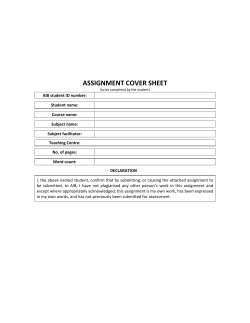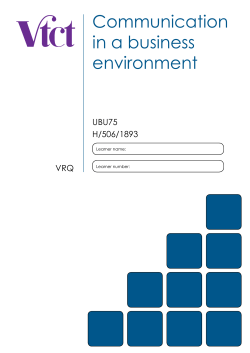
Understand the safe use of online and social media platforms
Understand the safe use of online and social media platforms UBU118 L/505/3514 Learner name: VRQ Learner number: VTCT is the specialist awarding organisation for the Hairdressing, Beauty Therapy, Complementary Therapy, Hospitality and Catering and Sport and Active Leisure sectors, with over 45 years of experience. VTCT is an awarding body regulated by national organisations including Ofqual, SQA, DfES and CCEA. VTCT is a registered charity investing in education and skills but also giving to good causes in the area of facial disfigurement. Statement of unit achievement By signing this statement of unit achievement you are confirming that all learning outcomes, assessment criteria and range statements have been achieved under specified conditions and that the evidence gathered is authentic. This statement of unit achievement table must be completed prior to claiming certification. Unit code Date achieved Learner signature Assessor initials IV signature (if sampled) Assessor tracking table All assessors using this Record of Assessment book must complete this table. This is required for verification purposes. Assessor name Assessor signature Assessors initials Assessor number (optional) UBU118 Understand the safe use of online and social media platforms The aim of this unit is to develop the knowledge and understanding to use online and social media platforms safely. You will be able to describe the different types of scams and frauds and how you can protect against these. You will learn about the potential risks to information security and the importance of controlling access to hardware, software and stored data. You will also learn about who can view information posted by you and the concept of no ‘take back’ with any information posted. UBU118_v1 Level 2 Credit value 4 GLH 35 Observation(s) 0 External paper(s) 0 Understand the safe use of online and social media platforms Learning outcomes On completion of this unit you will: 1. Understand that information stored on personal computers and mobile devices must be safeguarded 2. Know how to select and use appropriate security methods to safeguard systems and data 3. Understand the threats to personal safety when using the Internet 4. Know how to protect online devices against fraud and security attacks 5. Understand the implications of entering personal information onto social media networking sites 6. Evidence requirements 1. Knowledge outcomes There must be evidence that you possess all the knowledge and understanding listed in the Knowledge section of this unit. In most cases this can be done by professional discussion and/or oral questioning. Other methods, such as projects, assignments and/or reflective accounts may also be used. 2. Tutor/Assessor guidance Your tutor must refer to the ‘Skills CFA Assessment Strategy’ when delivering this unit. This can be found on www.vtct.org.uk under the relevant qualification page. You will be guided by your tutor/assessor on how to achieve learning outcomes in this unit. All outcomes must be achieved. Understand legal measures that address the protection of data For guidance on the assessment material for some individual units please refer to the ‘Assessment Guidance’. This can be found on www.vtct.org.uk under the relevant qualification page. 3. External paper There is no external paper requirement for this unit. UBU118 3 Developing knowledge Achieving knowledge outcomes You will be guided by your tutor and assessor on the evidence that needs to be produced. Your knowledge and understanding will be assessed using the assessment methods listed below*: • • • • • • • • • • Projects Observed work Witness statements Audio-visual media Evidence of prior learning or attainment Written questions Oral questions Assignments Case studies Professional discussion Where applicable your assessor will integrate knowledge outcomes into practical observations through professional discussion and/or oral questioning. When a criterion has been orally questioned and achieved, your assessor will record this evidence in written form or by other appropriate means. There is no need for you to produce additional evidence as this criterion has already been achieved. Some knowledge and understanding outcomes may require you to show that you know and understand how to do something. If you have practical evidence from your own work that meets knowledge criteria, then there is no requirement for you to be questioned again on the same topic. *This is not an exhaustive list. 4 UBU118 Knowledge Learning outcome 1 Understand that information stored on personal computers and mobile devices must be safeguarded You can: Portfolio reference a. Identify the potential risks to information security of using personal computers and mobile devices for: • using email • web browsing • banking online • shopping online • social networking b. Describe the security risks associated with: • hardware • software • social media networking • access to malicious websites • access to inappropriate material published on the Internet • corrupted or infected email attachments c. Explain the importance of controlling access to hardware, software and stored data d. Describe the common types of scams and frauds: • phishing • pharming • hacking e. Explain the importance of developing and maintaining safe ICT user habits UBU118 5 Learning outcome 2 Know how to select and use appropriate security methods to safeguard systems and data You can: a. Describe security techniques/measures that can protect personally accessed software and data, such as login identity and passwords b. Describe common ways of controlling access to hardware, software and data c. Identify ways to protect data and software d. Describe the term 'virus' and give examples of different types e. Describe the purpose of anti-virus software f. Explain why anti-virus software should be regularly updated g. Explain the importance of backing up and safely storing data 6 UBU118 Portfolio reference Learning outcome 3 Understand the threats to personal safety when using the internet You can: Portfolio reference a. Describe the forms and features of: • cyberbullying • grooming • stalking • criminal activities • inappropriate contact • inappropriate content b. Identify when and how to report online safety issues c. Describe the risks and consequences of: • identity theft • identity fraud d. Describe how user accounts can be used as a security measure when computers are used by more than one person e. Explain the importance of setting parental controls on personal computers, mobile and media devices f. Explain how to set up parental controls on: • personal computers • tablets • mobile phones UBU118 7 Learning outcome 4 Know how to protect online devices against fraud and security attacks You can: a. Set up security measures to protect personal computers and mobile devices against fraud and security threats b. Describe measures that can help to protect personal information c. Describe the risks posed by unsolicited email and measures that can reduce the risks d. Identify the security threats when accessing public WiFi networks 8 UBU118 Portfolio reference Learning outcome 5 Understand the implications of entering personal information onto social media networking sites You can: Portfolio reference a. Explain the concept of no ‘take backs’ once information is posted online b. Identify who can view information posted onto social media networking websites c. Explain the privacy issues of using social media websites d. Describe formal and informal conventions, or netiquette, which should be observed when communicating online e. Describe the potential consequences of posting your personal information onto social media websites f. Identify the security risks of adding geographic identity or location to material uploaded to the internet UBU118 9 Learning outcome 6 Understand legal measures that address the protection of data You can: a. Identify relevant legislation and guidelines relating to: • downloading images and files from the Internet • data protection b. Identify data protection issues around the use of social media c. Describe what is meant by the following terms: • copyright • plagiarism • intellectual property d. Explain why organisations develop and adopt policies for the acceptable use of ICT e. Describe the common components of an Acceptable Use Policy 10 UBU118 Portfolio reference
© Copyright 2025














